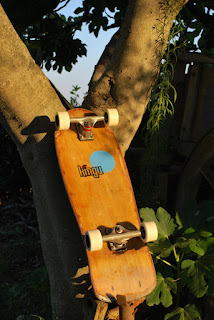tumblrrrrrrrrrrr.......
http://tavolekingu.tumblr.com/
venerdì 20 luglio 2012
lunedì 6 febbraio 2012
giovedì 8 dicembre 2011
venerdì 18 novembre 2011
MATITA 6'8" in vendita
martedì 25 ottobre 2011
venerdì 14 ottobre 2011
martedì 4 ottobre 2011
martedì 27 settembre 2011
martedì 6 settembre 2011
lunedì 15 agosto 2011
martedì 9 agosto 2011
venerdì 5 agosto 2011
Interpreting the Simmons Board part I
http://hydrodynamica.blogspot.com/2011/08/interpreting-simmons-board-part-i.html
"The Simmons surfboard is as strange an apparition today as when it first appeared. In its time it broke all rules of the day. It represents a shift from heavy displacement to light displacement along with the application of scientific theory. It was a radical departure, far ahead of its time, like the designer, and misunderstandings hindered its full acceptance. Bob Simmons disregarded criticism and just went surfing, which was his great love; his surfing proved the validity of his boards along with their use by a small cadre of followers.
From what he said and the body of research in his possession, along with a visual appraisal, one can get an idea of what he was pursuing. He was an aerodynamicist and a mathematician. That viewpoint must be kept in mind.
The boards had maximum width. Width was favored for the least resistance. Width plays a key role in delivering kinetic energy to the airfoil rail, the leading edge, that gives deflection. All planing hulls are deflectors. The airfoil is a special shape that is calculated. Width divided into length is aspect ratio, giving a magic number related to lift. Width also allows the hull to leave a clean wake. An impressive example of the value of width is the bodyboard.
The wide, unusually cambered, uplifted noses created a lot of criticism. The unknowing critics said they were pushing water, but they were in fact working, spreading the water momentarily, to the high pressure rails before take off. In a tough spot, where the nose comes into contact with the water, in a steep take off or large chop, they lifted. Changing the noses was not a big deal to him, saying they stick out when we surf. He rejected points as too fragile and dangerous. Some of his early boards had points...
The outlines were fair parallelism, contiguous rails, fared-in near the tail for clean stable running. Non-uniform outline shapes were rejected because of eddy flow resistance that increases with planing speed. This occurs at 10" in width. He is on record that trying to modify paddleboard shapes into surfboards was wrong; destroying the wide tail reduced early lift and clean resistance wakes. Those forms pulled the rail away from the wave and required a single fin, partly corrected with a tri fin today, which undoubtedly would have been rejected, because of increased appendage drag*. Rocker was rejected for reasons made obvious by his theory. 'Ya just don't need it!"
He rejected the notion that wide tails were the cause of 'spin-out" and considered it a fin problem. He moved a small fin to each outboard rail at the end and towed them in to 10 degrees. This is because the water is moving fastest at these points as it leaves the hull. A single centered fin is in the low pressure area of the board and away from the wave. He simply expressed, you need more fin at low speeds and less at high speeds. Simmons and his "test pilots" never spun out with dual fins, surfing the biggest and hardest breaking surf...He noted with criticism that narrow tails give a tubing, sucking wake. Anything that had eddy flow resistance was a "disaster" and "not the way to go!"
- John Elwell
from "Interpreting the Simmons Board"
published in the Surfers Journal
1994
photo of Elwell in the 50S with his beloved 9'0" Simmons.
* Simmons suggested to Bev Morgan that he try a 6'0" tri-fin.
"The Simmons surfboard is as strange an apparition today as when it first appeared. In its time it broke all rules of the day. It represents a shift from heavy displacement to light displacement along with the application of scientific theory. It was a radical departure, far ahead of its time, like the designer, and misunderstandings hindered its full acceptance. Bob Simmons disregarded criticism and just went surfing, which was his great love; his surfing proved the validity of his boards along with their use by a small cadre of followers.
From what he said and the body of research in his possession, along with a visual appraisal, one can get an idea of what he was pursuing. He was an aerodynamicist and a mathematician. That viewpoint must be kept in mind.
The boards had maximum width. Width was favored for the least resistance. Width plays a key role in delivering kinetic energy to the airfoil rail, the leading edge, that gives deflection. All planing hulls are deflectors. The airfoil is a special shape that is calculated. Width divided into length is aspect ratio, giving a magic number related to lift. Width also allows the hull to leave a clean wake. An impressive example of the value of width is the bodyboard.
The wide, unusually cambered, uplifted noses created a lot of criticism. The unknowing critics said they were pushing water, but they were in fact working, spreading the water momentarily, to the high pressure rails before take off. In a tough spot, where the nose comes into contact with the water, in a steep take off or large chop, they lifted. Changing the noses was not a big deal to him, saying they stick out when we surf. He rejected points as too fragile and dangerous. Some of his early boards had points...
The outlines were fair parallelism, contiguous rails, fared-in near the tail for clean stable running. Non-uniform outline shapes were rejected because of eddy flow resistance that increases with planing speed. This occurs at 10" in width. He is on record that trying to modify paddleboard shapes into surfboards was wrong; destroying the wide tail reduced early lift and clean resistance wakes. Those forms pulled the rail away from the wave and required a single fin, partly corrected with a tri fin today, which undoubtedly would have been rejected, because of increased appendage drag*. Rocker was rejected for reasons made obvious by his theory. 'Ya just don't need it!"
He rejected the notion that wide tails were the cause of 'spin-out" and considered it a fin problem. He moved a small fin to each outboard rail at the end and towed them in to 10 degrees. This is because the water is moving fastest at these points as it leaves the hull. A single centered fin is in the low pressure area of the board and away from the wave. He simply expressed, you need more fin at low speeds and less at high speeds. Simmons and his "test pilots" never spun out with dual fins, surfing the biggest and hardest breaking surf...He noted with criticism that narrow tails give a tubing, sucking wake. Anything that had eddy flow resistance was a "disaster" and "not the way to go!"
- John Elwell
from "Interpreting the Simmons Board"
published in the Surfers Journal
1994
photo of Elwell in the 50S with his beloved 9'0" Simmons.
* Simmons suggested to Bev Morgan that he try a 6'0" tri-fin.
mercoledì 3 agosto 2011
martedì 2 agosto 2011
martedì 26 luglio 2011
venerdì 22 luglio 2011
lunedì 13 giugno 2011
lunedì 6 giugno 2011
sabato 14 maggio 2011
venerdì 25 febbraio 2011
Iscriviti a:
Commenti (Atom)















































